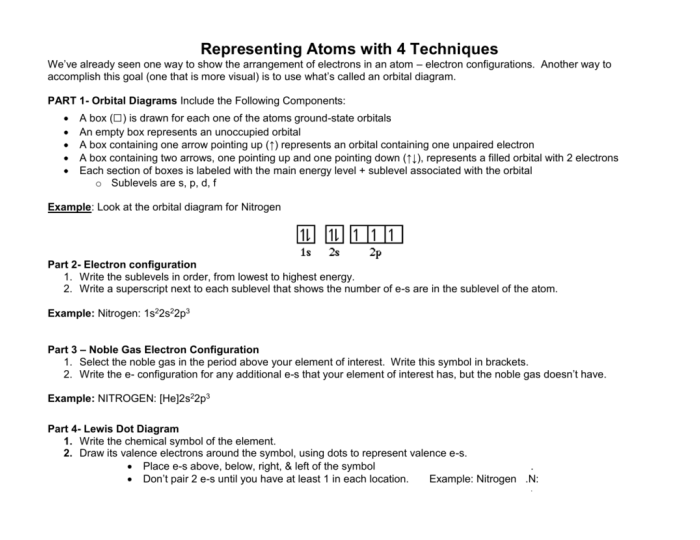Embark on a scientific odyssey with our comprehensive guide to electrons in atoms worksheet answers. Delve into the fascinating realm of electron configurations, energy levels, and orbitals, unraveling the fundamental principles that govern the arrangement of electrons within atoms.
Our meticulously crafted worksheet answers provide a roadmap to understanding the periodic trends and electron configurations, illuminating their profound impact on atomic size, ionization energy, and electronegativity. Explore the practical applications of electron configuration in chemistry, materials science, and spectroscopy, unlocking the secrets that shape the chemical world.
Electrons in Atoms Worksheet Answers
This worksheet provides practice with electron configuration and atomic structure. It includes questions on the number of electrons in each shell, the energy levels of electrons, and the shapes of orbitals.
Electron Shells
Electron shells are regions of space around the nucleus where electrons are likely to be found. The first shell is closest to the nucleus and can hold up to 2 electrons. The second shell can hold up to 8 electrons, and the third shell can hold up to 18 electrons.
Energy Levels
Electrons in each shell have a specific energy level. The energy level increases as the shell number increases. Electrons in the first shell have the lowest energy, and electrons in the outermost shell have the highest energy.
Orbitals
Orbitals are the three-dimensional regions around the nucleus where electrons are most likely to be found. There are four types of orbitals: s, p, d, and f. S orbitals are spherical, p orbitals are dumbbell-shaped, d orbitals have four lobes, and f orbitals have eight lobes.
Electron Configuration
The electron configuration of an atom is a description of the arrangement of electrons in the atom’s orbitals. The electron configuration is written as a string of numbers, where each number represents the number of electrons in a particular orbital.
For example, the electron configuration of helium is 1s 2. This means that helium has two electrons in its first shell, and no electrons in its other shells.
Electron Configuration of Various Elements
The following table summarizes the electron configurations of various elements:
| Element | Electron Configuration |
|---|---|
| Hydrogen | 1s1 |
| Helium | 1s2 |
| Lithium | 1s22s1 |
| Beryllium | 1s22s2 |
| Boron | 1s22s22p1 |
| Carbon | 1s22s22p2 |
| Nitrogen | 1s22s22p3 |
| Oxygen | 1s22s22p4 |
| Fluorine | 1s22s22p5 |
| Neon | 1s22s22p6 |
Electron Arrangement in Atoms

Electron arrangement in atoms is governed by several fundamental rules and principles that determine the distribution of electrons within an atom’s energy levels and orbitals.
Aufbau Principle
The Aufbau principle states that electrons occupy the lowest energy orbitals available before moving to higher energy levels. This means that electrons will first fill the 1s orbital before moving to the 2s, 2p, and so on.
Hund’s Rule
Hund’s rule states that when multiple orbitals of equal energy are available, electrons will occupy them singly before pairing up. This means that the 2p orbitals, for example, will each contain one electron before any of them contain two electrons.
Pauli Exclusion Principle
The Pauli exclusion principle states that no two electrons in an atom can have the same set of four quantum numbers. This means that each electron must have a unique combination of principal energy level (n), angular momentum quantum number (l), magnetic quantum number (ml), and spin quantum number (ms).
Electron Configurations
The electron configuration of an atom is a representation of the arrangement of electrons in its orbitals. It is written as a series of numbers and letters, where the numbers represent the principal energy level and the letters represent the orbital type (s, p, d, f).
For example, the electron configuration of helium (He) is 1s 2, which means that it has two electrons in the 1s orbital.
Periodic Trends and Electron Configuration: Electrons In Atoms Worksheet Answers
Electron configuration is the distribution of electrons in the atomic orbitals of an atom. It plays a crucial role in determining the chemical properties of an element and its position in the periodic table.
Atomic Size
The atomic size generally increases down a group and decreases across a period. This trend is due to the increase in the number of electron shells as you move down a group, leading to an increase in the distance between the nucleus and the outermost electrons.
Conversely, moving across a period increases the nuclear charge without adding new electron shells, resulting in a decrease in atomic size.
Ionization Energy
Ionization energy is the energy required to remove an electron from an atom. It generally increases across a period and decreases down a group. This trend is because the effective nuclear charge (the net positive charge experienced by an electron) increases across a period, making it more difficult to remove an electron.
Down a group, the effective nuclear charge remains relatively constant, while the distance between the nucleus and the outermost electrons increases, making it easier to remove an electron.
Electronegativity
Electronegativity is the ability of an atom to attract electrons towards itself. It generally increases across a period and decreases down a group. This trend is due to the increase in effective nuclear charge across a period, which makes the nucleus more strongly attractive to electrons.
Down a group, the effective nuclear charge remains relatively constant, while the distance between the nucleus and the outermost electrons increases, making the nucleus less strongly attractive to electrons.
Chemical Bonding
Electron configuration influences chemical bonding by determining the number and type of valence electrons available for bonding. Valence electrons are the electrons in the outermost shell of an atom, and they participate in chemical reactions. Atoms with similar electron configurations tend to have similar chemical properties and form similar types of bonds.
Electron Configuration and Chemical Properties
Electron configuration plays a crucial role in determining the chemical properties of elements. It influences their reactivity, bonding behavior, and overall chemical nature.
Relationship between Electron Configuration and Valence Electrons
The outermost electron shell, known as the valence shell, holds the valence electrons. These electrons are responsible for participating in chemical reactions and determining an element’s chemical properties. Elements with similar electron configurations, particularly in their valence shells, tend to exhibit similar chemical behavior.
Electron Configuration and Reactivity
The number of valence electrons affects an element’s reactivity. Elements with a high number of valence electrons, such as alkali metals, are highly reactive because they can easily lose these electrons to form positive ions. In contrast, elements with a low number of valence electrons, such as noble gases, are unreactive because they have stable electron configurations and are reluctant to lose or gain electrons.
Electron Configuration and Bonding Behavior, Electrons in atoms worksheet answers
Electron configuration also influences the bonding behavior of elements. Elements with unpaired valence electrons can form covalent bonds by sharing electrons to achieve a stable electron configuration. The number and arrangement of unpaired valence electrons determine the type and strength of bonds that an element can form.
Applications of Electron Configuration
Electron configuration plays a crucial role in various fields of chemistry and beyond. It provides insights into chemical reactions, properties of elements and compounds, and serves as a foundation for understanding atomic and molecular behavior.
One of the key applications of electron configuration is predicting chemical reactions. The reactivity of an element is largely determined by its outermost electrons, known as valence electrons. Elements with similar electron configurations tend to exhibit similar chemical properties. For instance, alkali metals (Group 1) all have one valence electron, making them highly reactive and forming 1+ ions.
Halogens (Group 17), on the other hand, have seven valence electrons and are highly electronegative, readily forming 1- ions.
Electron configuration also helps predict the stability and bonding behavior of molecules. The octet rule states that atoms tend to gain, lose, or share electrons to achieve a stable electron configuration with eight valence electrons, resembling the noble gases. This rule guides the formation of chemical bonds and explains the stability of many molecules.
Electron Configuration in Materials Science
In materials science, electron configuration is essential for understanding the electronic properties of materials. Metals, for example, have valence electrons that are loosely bound and can move freely throughout the material, giving rise to high electrical and thermal conductivity. Semiconductors, on the other hand, have a partially filled valence band and a narrow band gap, allowing them to control electrical conductivity under specific conditions.
Electron Configuration in Spectroscopy
In spectroscopy, electron configuration is used to interpret the absorption and emission spectra of atoms and molecules. Each element has a unique set of energy levels for its electrons, and when electrons transition between these levels, they absorb or emit photons of specific wavelengths.
By analyzing these spectra, scientists can identify and characterize elements and compounds, study their electronic structures, and gain insights into their chemical bonding.
User Queries
What is electron configuration?
Electron configuration refers to the distribution of electrons in different energy levels and orbitals around the atomic nucleus.
How does electron configuration affect atomic properties?
Electron configuration influences atomic size, ionization energy, electronegativity, and chemical reactivity.
What is the Aufbau principle?
The Aufbau principle states that electrons fill orbitals in order of increasing energy, starting with the lowest energy level.
